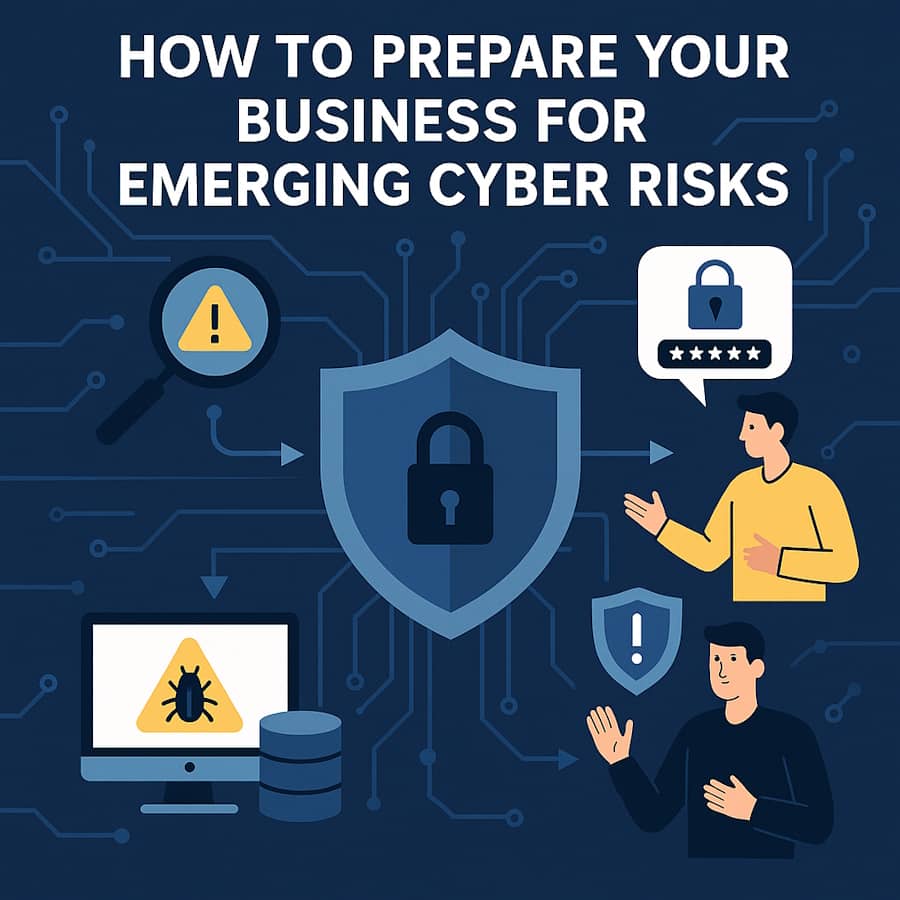Cyber threats are evolving faster than ever. Small and medium businesses face risks from ransomware, phishing, and data breaches. Preparing ahead is no longer optional. Waiting to react can cost time, money, and reputation. A single security incident can disrupt operations, compromise customer data, and damage your brand. This article explains practical steps to make your business resilient and ready for emerging cyber risks, focusing on people, processes, and technology.
Understand your current risk landscape
Preparation starts with understanding what your business relies on. Identify critical assets, systems, and sensitive data. Look at digital infrastructure, physical records, cloud services, and endpoints. Assess which systems, processes, or employees are most vulnerable.
Consider vendor and supply chain risks. Third-party providers can introduce security gaps if their practices are weak. Remote work adds another layer of exposure. Review all tools, software, and platforms your team uses daily. Map dependencies between systems and identify potential failure points. Include physical assets, such as office networks and on-site servers, in your review.
Frameworks like the NIST Cybersecurity Framework provide clear steps. Start by identifying risks, then move to protection, detection, response, and recovery. Document your findings. Create a risk matrix to prioritize the most critical vulnerabilities. Once you know your weaknesses, take targeted actions to address them. Risk assessment is not a one-time task; it should be updated regularly as your business grows or systems change.
Build robust protection and detection controls
Controls are your first line of defense. Access management is essential. Use strong passwords and multi-factor authentication for all systems. Limit access to sensitive data to only those who need it. Keep systems up to date and apply patches promptly.
Cybersecurity software, firewalls, and network segmentation reduce exposure. Backups are critical. Store copies offsite or in the cloud to ensure data recovery if a system is compromised. Encryption protects sensitive information both at rest and in transit. Implement endpoint protection and intrusion detection systems to detect and prevent attacks. Managed IT security services should also be considered for 24/7 expert threat monitoring and incident detection, especially where dedicated in-house security resources are limited.
Detection systems alert you to unusual activity. Log network traffic, monitor file access, and review system events regularly. Quick detection reduces potential damage from breaches. Combine prevention and detection measures for an effective strategy. Review your protection and detection controls periodically and adjust them as threats evolve.
Develop a culture of security awareness
Even strong technical controls fail if employees are unaware of risks. Phishing and social engineering exploit human error. Staff training is essential.
Introduce regular security awareness programs. Teach employees how to recognize phishing emails, suspicious links, and unsafe downloads. Simulate attacks to measure readiness. Encourage reporting of anomalies without fear of blame. Reinforce learning with short reminders, newsletters, or internal alerts.
Ongoing reinforcement builds a culture where employees actively protect business data, and it is a strategic advantage to build security awareness. Make security a regular part of your operations rather than a one-time event. Consider linking awareness programs to performance reviews or team metrics to encourage engagement.
Plan for response and recovery
Even the best defenses can fail. Planning how to respond and recover is critical. Develop an incident response plan with clear roles and responsibilities. Define steps to contain threats, notify stakeholders, and remediate issues. Include legal and regulatory considerations in your plan.
Develop a comprehensive business continuity plan. This plan should clearly outline essential operations that must be maintained during a cyber attack and the strategies for ensuring their uninterrupted continuation. Crucially, verify the reliability of all data backups and regularly test the restoration procedures. Formalize and document the entire recovery process for all systems, files, and customer data. Finally, establish clear communication protocols and defined escalation paths to facilitate quick and effective decision-making during an incident.
Regular drills and tabletop exercises ensure everyone knows what to do during an incident. Establish communication channels to keep employees, clients, and partners informed. Testing your plan highlights weaknesses before a real crisis occurs. Review and update plans regularly to address evolving threats. Include lessons learned from drills in staff training and procedural updates.
Monitor, review, and evolve your strategy
Cyber risk is not static as threats change, systems evolve, and your business grows. Regularly review risk assessments, controls, and policies. Audit your vendors and ensure they follow security best practices. Update software, hardware, and procedures as needed.
Use frameworks like ISO 27005 or NIST to guide continuous improvement. Leadership must be involved. Cybersecurity should be part of the overall business strategy, not just an IT concern. Evaluate new technologies before deployment. Understand the security implications of cloud tools, IoT devices, and hybrid record systems. Creating a hybrid records management system also helps balance digital and physical data protection while reducing operational risks.
Track security metrics over time. Monitor intrusion attempts, user behavior, and system performance. Use insights to prioritize updates, training, and technology investments. Establish a cycle of planning, action, and review to ensure ongoing resilience. Combine technical monitoring with employee and partner feedback for a comprehensive view.
Integrate proactive practices into daily operations
Embed security into your daily operations for maximum effectiveness. This includes enforcing strict device policies and requiring secure logins. Apply the principle of least privilege by limiting administrative access. Furthermore, segmenting your networks is crucial to restricting movement in the event of a security breach.
Regularly review and update access controls, software, and hardware configurations. Document changes and maintain an audit trail. This reduces the chance that gaps appear unnoticed. Maintain clear policies for remote and hybrid work arrangements. Establish a schedule for routine audits, system scans, and security checks.
Encourage reporting and feedback, as employees often spot issues before automated systems do. Make reporting easy and visible. Recognize good security behavior to reinforce the culture. Make cybersecurity part of team meetings, project planning, and daily workflows to maintain awareness and accountability.
Conclusion
Future cyber risks are inevitable, but preparation is key. Understand your risk landscape, build strong protection and detection controls, and develop employee security awareness. Plan for incidents, and continuously monitor and adapt strategies. Even small steps today, like reviewing systems or running awareness sessions, reduce potential loss and strengthen resilience. Planning now protects your data, reputation, and operations. The combination of technical controls, employee awareness, incident planning, and continuous monitoring forms a foundation to withstand challenges. Cybersecurity is an ongoing process; consistent application ensures your business remains secure and adaptable to evolving threats.








